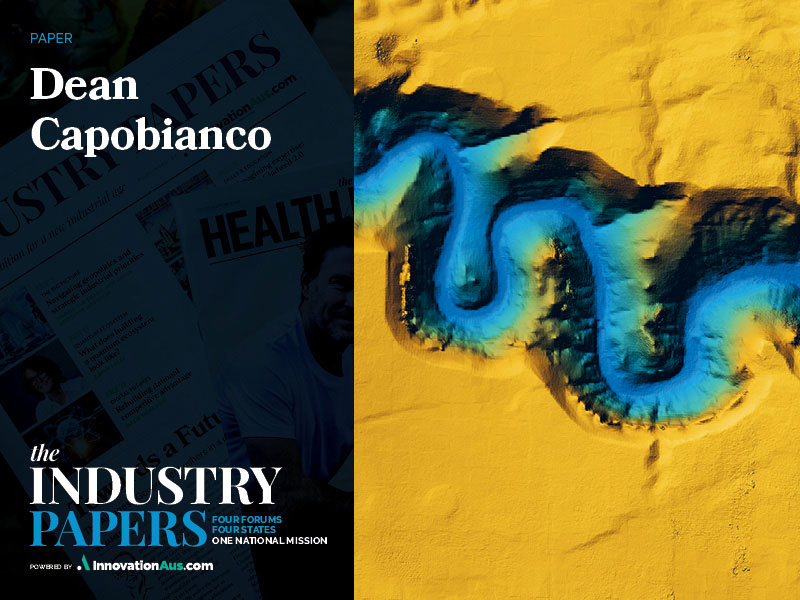When one thousand self-confessed map, data and tech nerds from 90 countries gathered in the Dutch city of Rotterdam in mid-May, it really drove home to me the advanced nature of Australia’s geospatial sector.
The four-day world forum brought together national mapping organisations, such as Geoscape Australia, along with hundreds of others from the broader geospatial market, which is forecast to have a global economic impact of $2.18 trillion by 2030.

The forum’s theme – powering the world economy – allowed for a broad-ranging and at times provocative discussion on the role played by geospatial organisations as the globe undergoes significant transitions and challenges.
Whether it’s the rollout of generative AI, the increasing number of extreme weather events, the economic and social transition to net zero, or the need to find long-lasting solutions to the housing crisis, the application of world-class location intelligence has never been more vital.
When the government talks about a future made in Australia, location intelligence can assist in so many ways – because everything happens somewhere.
To put it another way, the “power of the map” can help Australia become a smarter, cleaner, more productive nation, with an even brighter future.
Introduction to location intelligence
It’s not well known, but Australia’s location intelligence capability has been world-leading since 2004. That’s when Geoscape Australia, a national asset owned by all Australians, set out to digitise every single address in the land.
The result was the geocoded national address file, better known as G-NAF. According to Lateral Economics, Geoscape G-NAF will deliver over $1.4 billion in economic value to Australia over 15 years. This clearly illustrates the strong return on investment.
Through the Commonwealth’s ongoing financial commitment (totalling $114 million between 2015-2029) this national asset is free to the public.
Geoscape G-NAF is the definitive “source of truth” when it comes to location intelligence, and we are working overtime to place it at the heart of national efforts to transform our economy and meet the challenges ahead.
Whether it’s helping Australia Post optimise delivery routes, ensuring the integrity of the electoral roll for the Australian Electoral Commission, helping to plan and manage the Census, managing border crossings during the COVID-19 pandemic, helping insurance and banking companies manage their risk and asset valuations, or helping emergency services pinpoint specific locations, G-NAF is an underpinning national asset.
As highlighted in the Intergenerational Report 2023, “Australia’s future prosperity will be influenced by how well we manage and maximise the shifts underway in the economy.”
The growing use of digital and data technology, the challenge of climate change and the Net Zero transformation, the increasing demand for care and support services are some of the key shifts that Geoscape Australia has identified and which we have the ambition and means to address.
The application of critical location-based information
Nowhere is the opportunity and challenge greater than with climate change, as we experience a greater frequency of extreme weather events like floods and bushfires.
We also, of course, face a massive challenge in improving energy efficiency at both a household and business level as we try to reduce the nation’s carbon footprint. Decarbonising the economy is hard.
This is where location intelligence can play a pivotal role.
Location intelligence is being used to better manage the nation’s transport sector, which contributes around 21 per cent of our total carbon emissions, by providing data to support the thousands of heavy-vehicle journeys carried out each week.
Location data also enables technology to better plan the movement of heavy vehicles through enhanced compliance and management of interstate movements.
Likewise, Australia’s property sector is responsible for approximately 19 per cent of our total emissions.
Australia should create a national dataset that provides a climate profile for every single address or property right across the country.
This would achieve several things, for instance, measuring the energy profile of every building, no matter how remote the location. This could then help improve and better manage energy efficiency.
And this national dataset would be immensely valuable in providing crucial intelligence and information to planning authorities.
It could also provide crucial flood analytics for banks, insurance companies, town planners and other authorities, bringing data intelligence that could lead to more efficient homes being built.
Just imagine a nation where you could access key energy and emissions data on every house and apartment, every office block and warehouse.
This would give us greater insights into how our built environment is adapting over time to the challenge of climate change. It would pinpoint where we need to do better, for instance, when it comes to the rollout of household solar panels.
And it would deliver valuable information to inform the rollout of improved infrastructure for regional communities.
Britain’s Ordnance Survey (OS) has only recently introduced such a service as part of its Unlock Net Zero initiative. This service provides important information about a building’s age, or what it’s made of, helping town planners and other users better identify opportunities and risks.
I met with Ordnance Survey executives in May. I see OS as a shining example of how government and industry can work together to make a real difference in so many ways.
Ordnance Survey’s forward thinking Public Sector Geospatial Agreement (PSGA) is designed to set and support an innovation roadmap for location intelligence in the UK, leading to deeper partnership and realisation of the power of geospatial technology and data.
Using an alternative approach, Singapore’s Greenprint will help the Singapore economy collect, access and act upon ESG (environmental, social, governance) data.
This is a great idea and will allow businesses to be able to automate their ESG data, giving investors and regulators greater insights and paving the way for Singapore to become an even greener and cleaner economy.
Australia really has no choice but to do something similar, building on what we’ve already achieved through G-NAF and other open and publicly available data sets.
Every financial institution that we’re engaged with is utilising open Geoscape G-NAF as their underlying foundational address dataset and enriching it with the necessary industry-specific data and information to derive the insights required for improved decision-making.
The banking and insurance sectors would find a national climate dataset immensely valuable, to help them better plan for future risk and manage asset valuations, which would likely lead to fairer insurance premiums for consumers.
Across our agricultural sector, there are many cases where geospatial information is informing landowners and financiers of the current value and future viability of their agricultural lands.
Micro-climate data and soil nutrient information are assisting in the analysis and optimisation of land, and the prediction of crop yields.
Currently, there is no national operational farm boundary data. Farms typically consist of multiple parcels of land, which make it difficult to optimise supply chain management, and identify potential biosecurity challenges.
Here is another opportunity to support a vital Australian industry and ensure its future prosperity and support for regional communities.
We all know that Australia is vulnerable to climate change. Many of us have first-hand experience of these life-threatening events: of the floods that have ravaged large tracts of northern NSW and Queensland, and the summer bushfires that have consumed millions of acres of land in Western Australia, Northern Territory, New South Wales, South Australia and Victoria.
Again, this is where location intelligence is vital in terms of preparation and disaster management.
Last year, we signed a ground-breaking partnership agreement with the Finnish satellite provider, ICEYE, to allow emergency responders to access near-real-time fire damage reports during the bushfire season.
This is world-leading technology that allows ICEYE to capture accurate, high-resolution imagery of fire fronts and damage in any conditions, 24/7, in near-real-time.
Future Made in Australia
Location intelligence can help Australia further unlock its potential as one of the world’s leading nations and build a more productive economy that will be better able to weather future shocks.
We can be part of the generation that helps Australia build sovereign capability so that we are less reliant on global supply chains.
A national climate dataset will be useful to the thousands of businesses and enterprises that will be required to report carbon emission levels and physical risk under the new mandatory climate disclosure regime.
These are important reforms aimed at making Australia an even more attractive magnet for the trillions of dollars of global capital seeking opportunities to invest in the clean, green industries of the future.
In summary, there’s clear evidence that there is increasing recognition of the importance of the geospatial sector, from within government and across industry.
It fills me with a huge amount of confidence about the future of Geoscape Australia, and that we are an integral part of a growing global ecosystem.
Our ambition is to support this country’s most challenging economic issues, including climate management, insurance accessibility, housing affordability, and the supply of essential citizen services.
Our business will continue to diversify into new industries where we can help expand the geospatial capabilities that companies require to enable better decision-making, including:
- Using AI to interpret satellite and aerial imagery so that we can understand the construction materials, resilience and efficiency of every building nationally. We have this capacity now. Which is why I am so confident that we can better deploy location intelligence to build this smarter and more productive nation
- Working with government and industry to help identify the optimal locations to build the 1.2 million homes that need to be built over the next several years
- Deeper involvement with the insurance sector to identify locations and properties that are particularly vulnerable to flooding and other natural disasters
- Working with governments around Australia to help combat fraud, using location intelligence in a smart manner. We are doing this already to ensure people are not able to engage in fraud by, for instance, providing false addresses
- Providing support to our military and defence forces so they can use location intelligence to build Australia’s national security
These are all great initiatives, but we need to be more ambitious in embracing location intelligence as we embark on this transformation of the economy and society.
The need to keep investing in these assets will only become greater as we build a smarter and more productive nation.
I came away from the World Geospatial Forum in the Netherlands convinced that we are right up there with the best when it comes to location intelligence.
Who knows? We might even put in a bid to host a future gathering of self-confessed map, data and tech nerds here in this great southern land.
At a location yet to be identified.
Dean Capobianco, CEO, Geoscape Australia. Dean is an accomplished business and commercial leader and a former Olympic and World Championship track athlete. He is currently a non-executive director of T-shirt Ventures, the developer of a digital platform that guides people through the National Disability Insurance Scheme (NDIS). He is a senior adviser to Karlsgate Inc and has successfully built, scaled and transformed businesses in Australia and across the Asia Pacific region.
This article is part of The Industry Papers publication by InnovationAus.com. Order your hard copy here. 36 Papers, 48 Authors, 65,000 words, 72 page tabloid newspaper + 32 page insert magazine.
The Industry Papers is a big undertaking and would not be possible without the assistance of our valued sponsors. InnovationAus.com would like to thank Geoscape Australia, The University of Sydney Faculty of Science, the Semiconductor Sector Service Bureau (S3B), AirTrunk, InnoFocus, ANDHealth, QIMR Berghofer, Advance Queensland and the Queensland Government.
Do you know more? Contact James Riley via Email.

